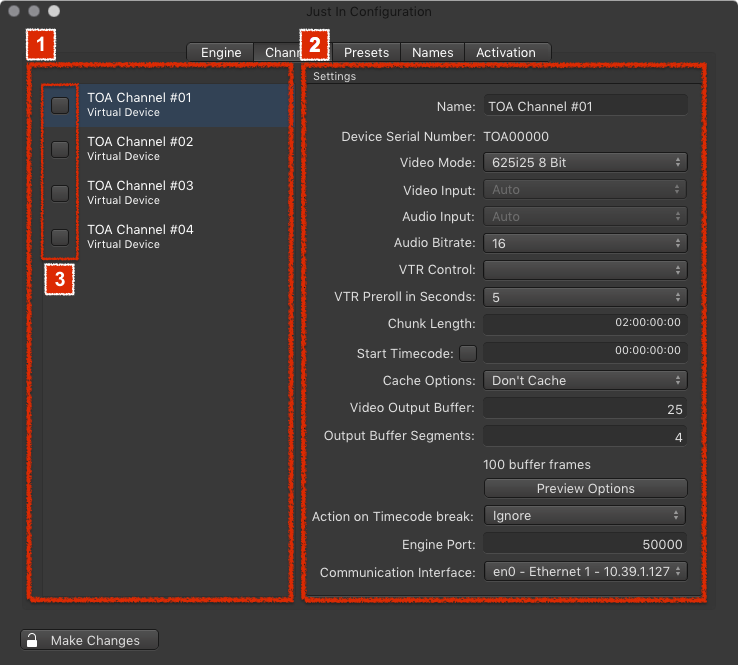Channels tab: select the available channels that you would like to configure and choose the appropriate settings for the channel. The available video modes for the previously selected framerate will be displayed automatically. Click on the appropriate checkbox to automatically activate the channel with the selected parameters.
On the left side you will see all the video capture devices found by the engine, as well as the chosen names for these devices. Please select a device to configure it.
Capture Devices List: Lists all video capture devices discovered by the engine.
Name: Enter the desired channel name.
Device: Displays the device model.
Video Mode: Configure the video mode. The available video modes for the previously selected engine framerate will be displayed accordingly.
Video Input: Select your video input.
Audio Input: Select your audio input.
...
| Info |
|---|
Depending on your Video device(s) the Channels tab may look differently. |
- Capture Devices (left side): lists supported Video capture devices. Click on a device to configure it.
- Name: the desired Channel name, which will also be displayed in just:in.
- Device Serial Number: shows the device serial number.
- Video Mode: select the Video mode.
- Video/Audio Input: select the Video/Audio input.
- Audio Bitrate: select the Audio bitrate (native 24-bit
- for AJA, selectable 16- or 24-bit for Blackmagic
- ).
- VTR Control:
- select the serial RS-422 connection you want to use to control your VTR.
- VTR Preroll in Seconds:
- set the desired VTR preroll value in seconds (1-10).
- Chunk Length:
- Defines the maximum length of the
- Container. The maximun Chunk Length is 12 hours.
- If the recording does not reach the entered Chunk Length, the clips will be automatically truncated
- to the expected recorded length.
- If the recording exceeds the entered Chunk Length, a new recording
- (generating a new clip
- ) will automatically be started.
- When recording in
- Crash Mode, clips will be added after the maximum record length has been reached
- .
- Start Timecode:
- enabling this option
- makes every new clip
- start
- with the defined timecode value.
- Cache Options:
- Don't Cache: usually files are written to disk in a stream (no caching, default).
- Cache: you can tell the storage controller to cache data in order to flush them later to disk to improve write performance.
- If you experience low write performance,
- enable caching.
- Video Output Buffer (QuickTime only): Number of A/V frames to flush to the storage system at once. If you want to flush once a second, just enter your
- Video framerate.
- Output Buffer Segments (QuickTime only): Number of buffer segments. The number of segments multiplied by the storage flush size is the total buffer size.
- We recommend not to exceed a total buffer size of 250 frames
- , otherwise the system may run out of RAM.
- Action on Timecode break:
- Ignore
- : Channel ignores timecode breaks.
- Create new file:
- Channel creates a new file
- upon a timecode break
- .
- Engine Port:
- port
- to access
- the Channel from just:in over an IP connection.
Communication Interface: Please choose an active network interface, which will
- Default is 50000.
- Communication Interface: select the network interface which should be used for establishing a connection to the user interface
- .
















